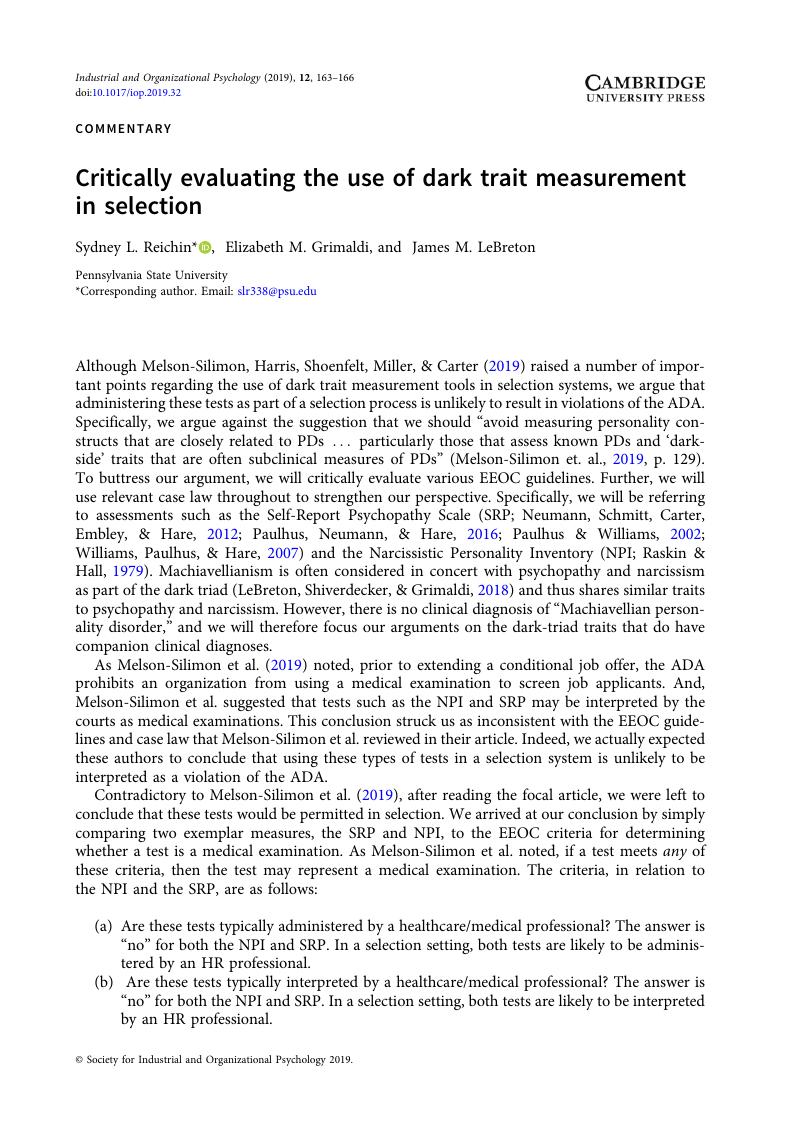No CrossRef data available.
Article contents
Critically evaluating the use of dark trait measurement in selection
Published online by Cambridge University Press: 01 August 2019
Abstract
An abstract is not available for this content so a preview has been provided. Please use the Get access link above for information on how to access this content.

- Type
- Commentaries
- Information
- Copyright
- © Society for Industrial and Organizational Psychology 2019
References
Equal Employment Opportunity Commission (EEOC). (2000). Enforcement Guidance: Disability-related inquiries and medical examinations of employees under the Americans with Disabilities Act (ADA). Retrieved from https://www.eeoc.gov/policy/docs/guidance-inquiries.html#N_33_
Google Scholar
Hathaway, S. R., & McKinley, J. C. (1940). A multiphasic personality schedule (Minnesota): I. construction of the schedule. Journal of Psychology, 10, 249–254.CrossRefGoogle Scholar
LeBreton, J. M., Shiverdecker, L. K., & Grimaldi, E. M. (2018). The dark triad and workplace behavior. Annual Review of Organizational Psychology and Organizational Behavior, 5, 387–414.CrossRefGoogle Scholar
Neumann, C. S., Schmitt, D. S., Carter, R., Embley, I., & Hare, R. D. (2012). Psychopathic traits in females and males across the globe. Behavioral Sciences & the Law, 30, 557–574. doi: 10.1002/bsl.2038
CrossRefGoogle ScholarPubMed
Melson-Silimon, A., Harris, A. M., Shoenfelt, E., Miller, J. D., & Carter, N. T. (2019). Personality testing and the Americans with Disabilities Act: Cause for concern as normal and abnormal models are integrated. Industrial and Organizational Psychology: Perspectives on Science and Practice, 12(2), 119–132.CrossRefGoogle Scholar
Paulhus, D. L., Neumann, C. S., & Hare, R. D. (2016). Manual for the Hare Self-Report Psychopathy scale. Toronto, ON: Multi-Health Systems.Google Scholar
Paulhus, D. L., & Williams, K. M. (2002). The dark triad of personality: Narcissism, Machiavellianism and psychopathy. Journal of Research in Personality, 36(6), 556–563. doi: 10.1016/S0092-6566(02)00505-6
CrossRefGoogle Scholar
Raskin, R., & Hall, C. S. (1979). A narcissistic personality inventory. Psychological Reports, 45, 590.CrossRefGoogle ScholarPubMed
Thompson v. Borg-Warner Protective Servs. Corp
., No. C-94-4015 MHP, 1996 W.L. 162990 (1996).Google Scholar
Williams, K. M., Paulhus, D. L., & Hare, R. D. (2007). Capturing the four-factor structure of psychopathy in college students via self-report. Journal of Personality Assessment, 88(2), 205–219. doi: 10.1080/00223890701268074
CrossRefGoogle ScholarPubMed




